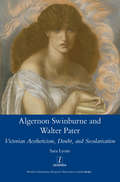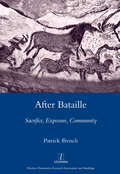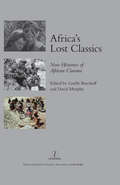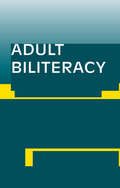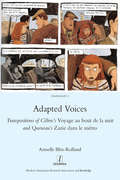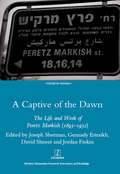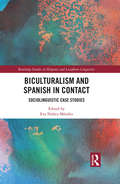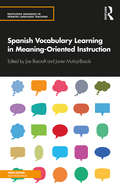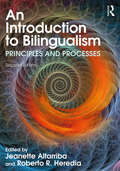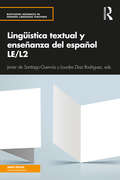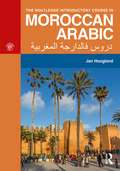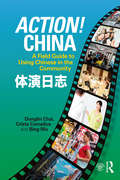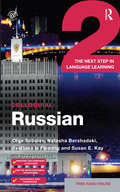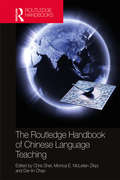- Table View
- List View
Algernon Swinburne and Walter Pater: Victorian Aestheticism, Doubt and Secularisation
by SarahGlendon LyonsHow did literary aestheticism emerge in Victorian Britain, with its competing models of religious doubt and visions of secularisation? For Lyons, the aestheticism developed and progressively revised by Algernon Charles Swinburne (1837-1909) and Walter Pater (1839-1894) illuminates the contradictory impulses of modern secularism: on the one hand, a desire to cast itself as a form of neutrality or disinterestedness; on the other, a desire to affirm 'this world' as the place of human flourishing or even enchantment. The standard narrative of a 'crisis of faith' does not do justice to the fissured, uncertain quality of Victorian visions of secularisation. Precisely because it had the status of a confusing hypothesis rather than a self-evident reality, it provoked not only dread and melancholia, but also forms of fantasy. Within this context Lyons gives a fundamentally new account of the aims and nature of Victorian aestheticism, taking as a focus its deceptively simple claim that art is for art's sake first of all.
Algernon Swinburne and Walter Pater: Victorian Aestheticism, Doubt and Secularisation
by SarahGlendon LyonsHow did literary aestheticism emerge in Victorian Britain, with its competing models of religious doubt and visions of secularisation? For Lyons, the aestheticism developed and progressively revised by Algernon Charles Swinburne (1837-1909) and Walter Pater (1839-1894) illuminates the contradictory impulses of modern secularism: on the one hand, a desire to cast itself as a form of neutrality or disinterestedness; on the other, a desire to affirm 'this world' as the place of human flourishing or even enchantment. The standard narrative of a 'crisis of faith' does not do justice to the fissured, uncertain quality of Victorian visions of secularisation. Precisely because it had the status of a confusing hypothesis rather than a self-evident reality, it provoked not only dread and melancholia, but also forms of fantasy. Within this context Lyons gives a fundamentally new account of the aims and nature of Victorian aestheticism, taking as a focus its deceptively simple claim that art is for art's sake first of all.
After Bataille: Sacrifice, Exposure, Community
by Patrick FfrenchAuthor of the obscene narrative Story of the Eye and of works of heretical philosophy such as Inner Experience, Georges Bataille (1897-1962) is one of the most powerful and secretly influential French thinkers of the last century. His work is driven by a compulsion to communicate an experience which exceeds the limits of communicative exchange, and also constitutes a sustained focus on the nature of this complusion. After Bataille takes this sense of compulsion as its motive and traces it across different figures in Batailles thought, from an obsession with the thematics and the event of sacrifice, through the exposure of being and of the subject, to the necessary relation to others in friendship and in community. In each of these instances After Bataille is distinctive in staging a series of encounters between Bataille, his contemporaries, and critics and theorists who extend or engage with his legacy. It thus offers a vital account of the place of Bataille in contemporary thought.
After Bataille: Sacrifice, Exposure, Community
by Patrick FfrenchAuthor of the obscene narrative Story of the Eye and of works of heretical philosophy such as Inner Experience, Georges Bataille (1897-1962) is one of the most powerful and secretly influential French thinkers of the last century. His work is driven by a compulsion to communicate an experience which exceeds the limits of communicative exchange, and also constitutes a sustained focus on the nature of this complusion. After Bataille takes this sense of compulsion as its motive and traces it across different figures in Batailles thought, from an obsession with the thematics and the event of sacrifice, through the exposure of being and of the subject, to the necessary relation to others in friendship and in community. In each of these instances After Bataille is distinctive in staging a series of encounters between Bataille, his contemporaries, and critics and theorists who extend or engage with his legacy. It thus offers a vital account of the place of Bataille in contemporary thought.
Africa's Lost Classics: New Histories of African Cinema
by Lizelle BisschoffUntil recently, the story of African film was marked by a series of truncated histories: many outstanding films from earlier decades were virtually inaccessible and thus often excluded from critical accounts. However, various conservation projects since the turn of the century have now begun to make many of these films available to critics and audiences in a way that was unimaginable just a decade ago. In this accessible and lively collection of essays, Lizelle Bisschoff and David Murphy draw together the best scholarship on the diverse and fragmented strands of African film history. Their volume recovers over 30 'lost' African classic films from 1920-2010 in order to provide a more complex genealogy and begin to trace new histories of African filmmaking: from 1920s Egyptian melodramas through lost gems from apartheid South Africa to neglected works by great Francophone directors, the full diversity of African cinema will be revealed.
Africa's Lost Classics: New Histories of African Cinema
by Lizelle BisschoffUntil recently, the story of African film was marked by a series of truncated histories: many outstanding films from earlier decades were virtually inaccessible and thus often excluded from critical accounts. However, various conservation projects since the turn of the century have now begun to make many of these films available to critics and audiences in a way that was unimaginable just a decade ago. In this accessible and lively collection of essays, Lizelle Bisschoff and David Murphy draw together the best scholarship on the diverse and fragmented strands of African film history. Their volume recovers over 30 'lost' African classic films from 1920-2010 in order to provide a more complex genealogy and begin to trace new histories of African filmmaking: from 1920s Egyptian melodramas through lost gems from apartheid South Africa to neglected works by great Francophone directors, the full diversity of African cinema will be revealed.
Adult Biliteracy: Sociocultural and Programmatic Responses
by AntonioOffering an in-depth view of adult literacy/biliteracy by merging two fields—adult literacy and English as a Second Language—this volume brings to the forefront linguistic, demographic, sociocultural, workforce, familial, academic, and other issues surrounding the development of bilingualism and biliteracy by adults in the U.S. As such, it helps to fill a gap in the research literature on language development among adults which has traditionally placed more emphasis on the development of oral English. Most important, it brings to light issues that are integral to the success of immigrant populations in the U.S.—issues that politicians, policymakers, educators, and employers must place at the top of their agendas as immigration reform is being formulated and implemented.Adult Biliteracy: Sociocultural and Programmatic Responses critically analyzes the assumptions that normalize monolingual and mono-literate approaches to adult education and to the teaching of English to immigrants and other language minorities in the U.S. By integrating theoretical principles with their applications, it furthers the discussion of the effects that bilingualism and biliteracy have on adult instruction. Applying research-based theoretical principles to the contexts in which adults learn, work, engage in civic participation, raise their children, and come together in community, this volume sheds light on the multiple ways in which adults use their first and second languages in the diverse sociocultural and educational contexts in which they function and learn in two languages.Highly relevant for researchers, professionals, and students concerned with second-language education, adult education, and applied linguistics, this book will particularly interest those whose work focuses on the education of immigrant and national language minorities.
Adult Biliteracy: Sociocultural and Programmatic Responses
by Klaudia M. Rivera Ana Huerta-MaciasOffering an in-depth view of adult literacy/biliteracy by merging two fields—adult literacy and English as a Second Language—this volume brings to the forefront linguistic, demographic, sociocultural, workforce, familial, academic, and other issues surrounding the development of bilingualism and biliteracy by adults in the U.S. As such, it helps to fill a gap in the research literature on language development among adults which has traditionally placed more emphasis on the development of oral English. Most important, it brings to light issues that are integral to the success of immigrant populations in the U.S.—issues that politicians, policymakers, educators, and employers must place at the top of their agendas as immigration reform is being formulated and implemented.Adult Biliteracy: Sociocultural and Programmatic Responses critically analyzes the assumptions that normalize monolingual and mono-literate approaches to adult education and to the teaching of English to immigrants and other language minorities in the U.S. By integrating theoretical principles with their applications, it furthers the discussion of the effects that bilingualism and biliteracy have on adult instruction. Applying research-based theoretical principles to the contexts in which adults learn, work, engage in civic participation, raise their children, and come together in community, this volume sheds light on the multiple ways in which adults use their first and second languages in the diverse sociocultural and educational contexts in which they function and learn in two languages.Highly relevant for researchers, professionals, and students concerned with second-language education, adult education, and applied linguistics, this book will particularly interest those whose work focuses on the education of immigrant and national language minorities.
Adapted Voices
by Armelle Blin-RollandVoyage au bout de la nuit (1932), by Louis-Ferdinand Celine (1894-1961), and Zazie dans le metro (1959), by Raymond Queneau (1903-1976), were two revolutionary novels in their transposition of spoken language into written language. Since their publication they have been adapted into a broad range of media, including illustrated novel, bande dessinee, film, stage performance and recorded reading. What happens to their striking literary voices as they are transposed into media that combine text and image, sound and image, or consist of sound alone? In this study, Armelle Blin-Rolland examines adaptations sparked by these two seminal novels to understand what 'voice' means in each medium, and its importance in the process of adaptation.
Adapted Voices
by Armelle Blin-RollandVoyage au bout de la nuit (1932), by Louis-Ferdinand Celine (1894-1961), and Zazie dans le metro (1959), by Raymond Queneau (1903-1976), were two revolutionary novels in their transposition of spoken language into written language. Since their publication they have been adapted into a broad range of media, including illustrated novel, bande dessinee, film, stage performance and recorded reading. What happens to their striking literary voices as they are transposed into media that combine text and image, sound and image, or consist of sound alone? In this study, Armelle Blin-Rolland examines adaptations sparked by these two seminal novels to understand what 'voice' means in each medium, and its importance in the process of adaptation.
A Captive of the Dawn: The Life and Work of Peretz Markish (1895-1952)
by Joseph ShermanPeretz Markish (1895-1952), one of Eastern Europe's most important Yiddish poets in the period between the two world wars, was a fiercely independent maverick who published work in all literary genres. Although emerging from the Kiev literary tradition, Markish always went his own way in a literary career spanning four decades and embracing almost
A Captive of the Dawn: The Life and Work of Peretz Markish (1895-1952)
by Joseph ShermanPeretz Markish (1895-1952), one of Eastern Europe's most important Yiddish poets in the period between the two world wars, was a fiercely independent maverick who published work in all literary genres. Although emerging from the Kiev literary tradition, Markish always went his own way in a literary career spanning four decades and embracing almost
Biculturalism and Spanish in Contact: Sociolinguistic Case Studies (Routledge Studies in Hispanic and Lusophone Linguistics)
by Eva Núñez-Méndez Dale Koike Javier Muñoz-BasolsBiculturalism and Spanish in Contact: Sociolinguistic Case Studies provides an original and modern analysis of the field of language change and variation with a specific focus on Spanish as a language in contact. This edited collection, focuses on diachronic variationist approaches to the Spanish language in contact with other languages from a historical sociolinguistics perspective. Topics covered include: language planning and policies, education, biculturalism, linguistic variation issues in the Spanish of the southwestern United States, and other socio-historical and anthropological aspects of the contact situation.
Biculturalism and Spanish in Contact: Sociolinguistic Case Studies (Routledge Studies in Hispanic and Lusophone Linguistics)
by Eva Núñez MéndezBiculturalism and Spanish in Contact: Sociolinguistic Case Studies provides an original and modern analysis of the field of language change and variation with a specific focus on Spanish as a language in contact. This edited collection, focuses on diachronic variationist approaches to the Spanish language in contact with other languages from a historical sociolinguistics perspective. Topics covered include: language planning and policies, education, biculturalism, linguistic variation issues in the Spanish of the southwestern United States, and other socio-historical and anthropological aspects of the contact situation.
Spanish Vocabulary Learning in Meaning-Oriented Instruction (Routledge Advances in Spanish Language Teaching)
by Joe Barcroft Javier Muñoz-BasolsSpanish Vocabulary Learning in Meaning-Oriented Instruction is the first comprehensive overview of current research and instructional practices into Spanish vocabulary acquisition through the lens of Meaning-Oriented Instruction (MOI). Key features: • a breadth of topics including language variation, input, tasks and processing specificity, incidental learning, idiomatic language, lexicographic perspectives, lexicosemantic representation, vocabulary testing, and receptive and productive vocabulary; • a combination of theory and practical guidance highlighting pedagogical best practices in the teaching of vocabulary; • guidance on the difficulties teachers face when teaching vocabulary in the classroom; • clear explanations with plenty of examples and useful references; • tasks and activities that help teachers move from a traditional curricular approach to a more innovative and engaging one focused on communicating, completing tasks, and learning content. Written by an international cohort of scholars in a succinct and accessible manner, Spanish Vocabulary Learning in Meaning-Oriented Instruction is an essential resource for teachers of Spanish at all levels. It is also an excellent reference book for researchers and both undergraduate and graduate students interested in Spanish vocabulary acquisition.
Spanish Vocabulary Learning in Meaning-Oriented Instruction (Routledge Advances in Spanish Language Teaching)
by Joe Barcroft Javier Muñoz-BasolsSpanish Vocabulary Learning in Meaning-Oriented Instruction is the first comprehensive overview of current research and instructional practices into Spanish vocabulary acquisition through the lens of Meaning-Oriented Instruction (MOI). Key features: • a breadth of topics including language variation, input, tasks and processing specificity, incidental learning, idiomatic language, lexicographic perspectives, lexicosemantic representation, vocabulary testing, and receptive and productive vocabulary; • a combination of theory and practical guidance highlighting pedagogical best practices in the teaching of vocabulary; • guidance on the difficulties teachers face when teaching vocabulary in the classroom; • clear explanations with plenty of examples and useful references; • tasks and activities that help teachers move from a traditional curricular approach to a more innovative and engaging one focused on communicating, completing tasks, and learning content. Written by an international cohort of scholars in a succinct and accessible manner, Spanish Vocabulary Learning in Meaning-Oriented Instruction is an essential resource for teachers of Spanish at all levels. It is also an excellent reference book for researchers and both undergraduate and graduate students interested in Spanish vocabulary acquisition.
An Introduction to Bilingualism: Principles and Processes
by Jeanette Altarriba and Roberto R. HerediaThe study of bilingualism and all of its aspects – from theory and models to social approaches and their practical applications – forms the cornerstone of the 2nd edition of this work. The chapters cover the latest advancements in the domains of psycholinguistics, neuroscience, creativity, and executive functioning. Contributions, new to this edition, offer the reader the most up-to-date research on lifespan and developmental issues. The work also provides insight into how human language is processed by all, not just by bilingual and multilingual speakers.This text is ideal for senior undergraduate and graduate courses in psycholinguistics and the psychology of language, especially those with an emphasis on bilingualism or second language learning.
An Introduction to Bilingualism: Principles and Processes
by Jeanette Altarriba Roberto R. HerediaThe study of bilingualism and all of its aspects – from theory and models to social approaches and their practical applications – forms the cornerstone of the 2nd edition of this work. The chapters cover the latest advancements in the domains of psycholinguistics, neuroscience, creativity, and executive functioning. Contributions, new to this edition, offer the reader the most up-to-date research on lifespan and developmental issues. The work also provides insight into how human language is processed by all, not just by bilingual and multilingual speakers.This text is ideal for senior undergraduate and graduate courses in psycholinguistics and the psychology of language, especially those with an emphasis on bilingualism or second language learning.
Lingüística textual y enseñanza del español LE/L2 (Routledge Advances in Spanish Language Teaching)
by Javier de Santiago-Guervós; Lourdes Díaz Rodríguez; Javier Muñoz-BasolsLingüística textual y enseñanza del español LE/L2 ofrece una visión de conjunto teórico-práctica y actualizada de la Lingüística textual aplicada a la enseñanza del español como lengua extranjera y/o segunda, destinada especialmente a estudiantes graduados y a profesores en formación nativos y no nativos. El volumen, escrito por un elenco internacional de profesores-investigadores, presenta una visión actualizada y práctica de los géneros textuales más frecuentes en programaciones universitarias. Enmarcado por una síntesis actualizada de estudios e investigaciones en lingüística aplicada que recorre distintas perspectivas teóricas y metodológicas, recoge datos y propuestas procedentes de aulas de aprendizaje de español de distintos contextos internacionales. Su principal propósito es suscitar la reflexión teórico-práctica sobre los géneros discursivos y su papel en el aula, y ofrecer una descripción pormenorizada de los mismos para proporcionar al profesorado en formación, nativo y no nativo, recursos prácticos y propuestas didácticas que ejemplifican y guían de manera razonada cómo llevar al aula los distintos géneros textuales. Características principales: • Amplitud de aspectos de la lingüística textual y géneros discursivos abordados enteramente para el español LE/L2 y en español. • Estructuración homogénea de los capítulos que facilita la lectura y da coherencia al conjunto. Atención a géneros escritos y orales desde una perspectiva teórico-práctica que puede inspirar nuevas investigaciones. Atención a la diversidad geolectal del español, a los contextos en que este es L2 (Europa, EEUU) y a la de sus aprendices (hablantes de herencia, L2, LE). Orientado a la aplicación práctica y docente en la clase de L2/LE, cada capítulo dedicado a un género incluye consejos, pautas o actividades para el aula. Incluye temática actual en lingüística textual y aprendizaje de lenguas: escritura académica, divulgación científica, textos jurídicos, aprendizaje mediado por ordenador o el lenguaje de las redes. Capítulos bien fundamentados teórica y bibliográficamente, con sólido respaldo de datos empíricos procedentes de corpus, bien contextualizados. Aborda los aspectos teóricos tradicionales relativos al estudio de la tipología textual y los desafíos metodológicos que afronta el profesor al llevar al aula los distintos géneros discursivos. La presente obra presenta, en un solo volumen, una visión actualizada y práctica de los tipos textuales y géneros discursivos de uso más frecuente desde una perspectiva teórico-práctica: presentación, descripción y puesta en práctica es un esquema de trabajo directo y enormemente útil para su aplicación en el aula. El ámbito internacional en el que se mueven los autores le da una amplitud nunca antes recogida en una obra de lingüística textual. Todo ello hace de Lingüística textual y enseñanza del español LE/L2 una obra de consulta obligada para docentes de español como LE/L2, para estudiantes graduados y formadores de profesores, así como para cualquier persona que desee adquirir una perspectiva actual sobre lingüística textual, géneros discursivos y enseñanza e investigación en español nativo y no nativo.
Lingüística textual y enseñanza del español LE/L2 (Routledge Advances in Spanish Language Teaching)
by Javier De Santiago-Guervós Lourdes Díaz RodriguezLingüística textual y enseñanza del español LE/L2 ofrece una visión de conjunto teórico-práctica y actualizada de la Lingüística textual aplicada a la enseñanza del español como lengua extranjera y/o segunda, destinada especialmente a estudiantes graduados y a profesores en formación nativos y no nativos. El volumen, escrito por un elenco internacional de profesores-investigadores, presenta una visión actualizada y práctica de los géneros textuales más frecuentes en programaciones universitarias. Enmarcado por una síntesis actualizada de estudios e investigaciones en lingüística aplicada que recorre distintas perspectivas teóricas y metodológicas, recoge datos y propuestas procedentes de aulas de aprendizaje de español de distintos contextos internacionales. Su principal propósito es suscitar la reflexión teórico-práctica sobre los géneros discursivos y su papel en el aula, y ofrecer una descripción pormenorizada de los mismos para proporcionar al profesorado en formación, nativo y no nativo, recursos prácticos y propuestas didácticas que ejemplifican y guían de manera razonada cómo llevar al aula los distintos géneros textuales. Características principales: • Amplitud de aspectos de la lingüística textual y géneros discursivos abordados enteramente para el español LE/L2 y en español. • Estructuración homogénea de los capítulos que facilita la lectura y da coherencia al conjunto. Atención a géneros escritos y orales desde una perspectiva teórico-práctica que puede inspirar nuevas investigaciones. Atención a la diversidad geolectal del español, a los contextos en que este es L2 (Europa, EEUU) y a la de sus aprendices (hablantes de herencia, L2, LE). Orientado a la aplicación práctica y docente en la clase de L2/LE, cada capítulo dedicado a un género incluye consejos, pautas o actividades para el aula. Incluye temática actual en lingüística textual y aprendizaje de lenguas: escritura académica, divulgación científica, textos jurídicos, aprendizaje mediado por ordenador o el lenguaje de las redes. Capítulos bien fundamentados teórica y bibliográficamente, con sólido respaldo de datos empíricos procedentes de corpus, bien contextualizados. Aborda los aspectos teóricos tradicionales relativos al estudio de la tipología textual y los desafíos metodológicos que afronta el profesor al llevar al aula los distintos géneros discursivos. La presente obra presenta, en un solo volumen, una visión actualizada y práctica de los tipos textuales y géneros discursivos de uso más frecuente desde una perspectiva teórico-práctica: presentación, descripción y puesta en práctica es un esquema de trabajo directo y enormemente útil para su aplicación en el aula. El ámbito internacional en el que se mueven los autores le da una amplitud nunca antes recogida en una obra de lingüística textual. Todo ello hace de Lingüística textual y enseñanza del español LE/L2 una obra de consulta obligada para docentes de español como LE/L2, para estudiantes graduados y formadores de profesores, así como para cualquier persona que desee adquirir una perspectiva actual sobre lingüística textual, géneros discursivos y enseñanza e investigación en español nativo y no nativo.
The Routledge Introductory Course in Moroccan Arabic: An Introductory Course
by Jan HooglandThe Routledge Introductory Course in Moroccan Arabic is ideal for both class-based and independent learners. No prior knowledge of Arabic is required as the course guides you step-by-step through the essentials of the language. Transliteration is used throughout to provide learners with an accurate representation of this spoken language while Arabic script is provided from Part II for those who have prior knowledge of Arabic. Part I introduces the phonology of Moroccan allowing you to recognise and pronounce the sounds unique to Moroccan. The basic grammar of Moroccan is also presented here ensuring students have a solid foundation on which to build their communicative skills. Part II is arranged thematically and equips you with the vocabulary and cultural information needed to communicate effectively in Morocco in a range of common situations. By the end of the course learners will have reached the CEFR A2 level/ACTFL Intermediate-Mid.
The Routledge Introductory Course in Moroccan Arabic
by Jan HooglandThe Routledge Introductory Course in Moroccan Arabic is ideal for both class-based and independent learners. No prior knowledge of Arabic is required as the course guides you step-by-step through the essentials of the language. Transliteration is used throughout to provide learners with an accurate representation of this spoken language while Arabic script is provided from Part II for those who have prior knowledge of Arabic. Part I introduces the phonology of Moroccan allowing you to recognise and pronounce the sounds unique to Moroccan. The basic grammar of Moroccan is also presented here ensuring students have a solid foundation on which to build their communicative skills. Part II is arranged thematically and equips you with the vocabulary and cultural information needed to communicate effectively in Morocco in a range of common situations. By the end of the course learners will have reached the CEFR A2 level/ACTFL Intermediate-Mid.
Action! China: A Field Guide to Using Chinese in the Community
by Donglin Chai Crista Cornelius Bing MuWinner of the Chinese Language Teachers Association’s 2014 Cengage Learning Excellence and Innovation in Teaching Chinese Award. Action! China is a practical guide for intermediate to advanced students of Chinese wanting to maximize their study abroad experience and enhance their language skills. This handy guide contains over 90 Field Performance tasks which prompt real-life interactions with native speakers. By carrying out these real-life tasks students refine and solidify existing communication skills and gain a fuller understanding of and participation in the target culture. The guide also provides over 60 Performance Watch tasks which help students understand how native speakers accomplish communicative goals through guided observation and analysis of naturally occurring interactions. Action! China helps students understand and participate socially in Chinese, guiding them through skill-getting and skill-using processes and enabling them to form meaningful connections with Chinese people in the community.
Colloquial Russian 2: The Next Step in Language Learning (Colloquial Series)
by Olga Sobolev Natasha Bershadski Svetlana Le Fleming Susan E. KayColloquial Russian 2 is the ideal way to refresh your knowledge of the language and to extend your skills. Structured to give you the opportunity to listen to and read lots of modern, everyday Russian, Colloquial Russian 2 has been developed to work systematically on reinforcing and extending your grasp of Russian grammar, vocabulary, intercultural communication skills, and understanding of contemporary Russian society. New to this edition: revision material to help consolidate and build up learners’ basics; a wide range of authentic and up-to-date reading materials, including blogs, forums, surveys, opinion pieces, and commentaries; exercises based on role plays, group activities, and debating techniques, aimed at developing oral communication and expanding vocabulary range of learners; and new audio material including authentic and up-to-date audio excerpts. Audio material to accompany the course is available to download free in MP3 format from www.routledge.com/cw/colloquials. Recorded by native speakers, the audio material features the dialogues and texts from the book and will help develop your listening and pronunciation skills.
The Routledge Handbook of Chinese Language Teaching
by Chris Shei Monica E McLellan Zikpi Der-Lin ChaoThe Routledge Handbook of Chinese Language Teaching defines Chinese language teaching in a pedagogical, historical, and contemporary context. Throughout the volume, teaching methods are discussed, including the traditional China-based approach, and Western methods such as communicative teaching and the immersion program. The Handbook also presents a pedagogical model covering pronunciation, tones, characters, vocabulary, grammar, and the teaching of listening, speaking, reading, and writing. The remaining chapters explore topics of language assessment, technology enhanced instruction, teaching materials and resources, Chinese for specific purposes, classroom implementation, social contexts of language teaching and language teaching policies, and pragmatics and culture. Ideal for scholars and researchers of Chinese language teaching, the Handbook will benefit educators and teacher training programs. This is the first comprehensive volume exploring the growing area of Chinese language pedagogy.
